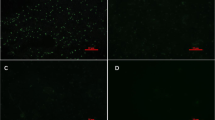Abstract
Background and aim
Burkholderia mallei, the etiologic agent of the disease known as glanders. Clinical and bacteriological diagnosis of glanders is difficult in the early stages of the disease. Currently, mallein (allergic hypersensitivity test) is used for the diagnosis of glanders. The mallein test requires an experienced laboratory person and lasts 48 h. Therefore, in order to quickly diagnose the disease, especially in areas (such as the borders of the country) that cannot be kept animals, new methods should be used to identify the disease. The Rose Bengal is a serological diagnostic test and has been recommended by the World Organization for Animal Health (OIE). In this study, the Rose Bengal test (RBT) was evaluated for the diagnosis of equine glanders, and its diagnostic was compared with mallein test.
Materials and methods
Sera from 70 naturally infected culture-positive horses, 3 equines that were sensitized by injecting antigen and 110 healthy equines were tested. Specificity and sensitivity of RBT and mallein test when testing culture-positive equines were calculated.
Results
Diagnosis of glanders with both methods yield the same results, but Rose Bengal test is much faster than mallein test for diagnosis of equine glanders.
Conclusion
By comparative RBT with mallein test, it can be considered, RBT test has been used for rapid detection of glanders with features such as, ease of use and can be applicable without specialized equipment and trained personnel. Because the RBT is simpler and rapid to perform, the inclusion of the test as a supplementary test for the diagnosis of glanders in field conditions is recommended.





Similar content being viewed by others
References
Acha, P.N., Szyfres, B. 1987. Glanders. In Zoonoses and communicable diseases common to man and animals. Volume 503. 2nd edition. Washington: Pan American Health Organization, 86–89.
Van Zandt, E.K., Greer, M.T., Gelhaus, H.C. 2013. Glanders: an overview of infection in humans. Orphanet Journal of Rare Diseases 8, 131–136.
Lehavi, O., Aizenstien, O., Katz, L.H., Hourvitz, A. 2002. Glanders: a potential biological warfare against humans and animals. Harefauh 140, 88–91.
Ulrich, R.K., Ulrich, M.P., Schell, M.A., Kime, H.S., DeShazer, D. 2006. Development of a polymerase chain reaction assay for the specific identification of Burkholderia mallei and differentiation from Burkholderia pseudomallei and other closely related Burkholderiaceae. Diagnostic Microbiology and Infectious Disease 55, 37–45.
Khan, I., Wieler, L.H., Melzer, F., Elschner, M.C., Muhammad, G., Ali, S., et al. 2013. Glanders in animals: a review on epidemiology, clinical presentation, diagnosis and countermeasures. Transboundary and Emerging Diseases 60(3), 204–221.
Naureen, A., Saqib, M., Muhammad, G., Hussain, M.H., Asi, M.N. 2007. Comparative evaluation of Rose Bengal plate agglutination test, mallein test, and some conventional serological tests for diagnosis of equine Glanders. Journal of Veterinary Diagnostic Investigation 19(4), 362–367.
Jana, A.M., Gupta, A.K., Pandya, G., Verma, R.D. 1982. Rapid diagnosis of Glanders in equines by counter-immuno-electrophoresis. Indian Veterinary Journal 59, 5–9.
Neubauer, H., Sprague, L.D., Zachria, R., Tomaso, H., Al Dahouk, S., Wernery, R., et al. 2005. Serodiagnosis of Burkholderia mallei infections in horses: state-of-theart and perspectives. Journal of veterinary medicine B 52(5), 201–205.
de Carvalho Filho, M.B., Ramos, R.M., Fonseca, A.A., de Lima Orzil, L., Sales, M.L., de Assis Santana, V.L., et al. 2012. Development and validation of a method for purification of mallein for the diagnosis of Glanders in equines. BMC Veterinary Research 8, 1–9.
Sprague, L.D., Zachariah, R., Neubauer, H., Wernery, R., Joseph, M., Scholz, HC., Wernery, U. 2009. Prevalence-dependent use of serological tests for diagnosing Glanders in horses. BMC Veterinary Research 5, 1–6
Khaki, P., Mosavari, N., Khajeh, N.S., Emam, M., Ahouran, M., Hashemi, S., et al. 2012. Glanders outbreak at Tehran Zoo, Iran. Iranian Journal of Microbiology 4(1), 3–7.
Bazargani, T., Tadjbakhsh, H., Badii, A., Zahraei, T. 1996. The outbreak of Glanders in some racehorses in three states of Iran. Journal of Equine Veterinary Science 16(6), 232–236.
De Shazer, D., Waag, D.M., Fritz, D. L, Woods, D.E. 2001. Identification of a Burkholderia mallei polysaccharide gene cluster by subtractive hybridization and demonstration that the encoded capsule is an essential virulence determinant. Microbial pathogenesis 30(5): 253–269.
Kettle, A.N., Wernery, U. 2016. Glanders and the risk for its introduction through the international movement of horses. Equine Veterinary Journal 48(5): 654–658.
Author information
Authors and Affiliations
Corresponding author
Ethics declarations
Conflict of interest
The authors declare that they have no conflict of interest.
Additional information
Publisher’s note
Springer Nature remains neutral with regard to jurisdictional claims in published maps and institutional affiliations.
Rights and permissions
About this article
Cite this article
Karimi, A., Mosavari, N. Development of Rose Bengal test against mallein test for rapid diagnosis of equine glanders. Trop Anim Health Prod 51, 1969–1974 (2019). https://doi.org/10.1007/s11250-019-01890-6
Received:
Accepted:
Published:
Issue Date:
DOI: https://doi.org/10.1007/s11250-019-01890-6




